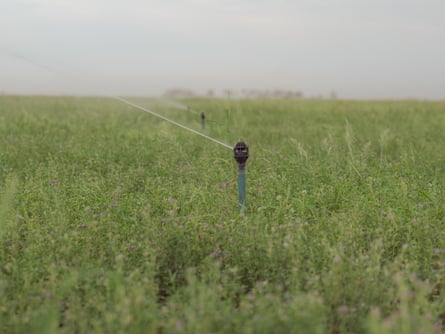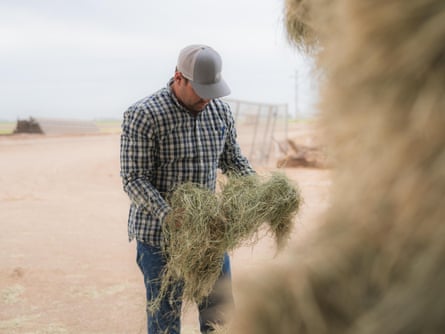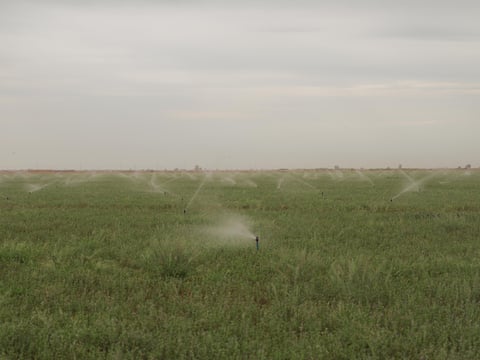On an early August morning in California’s Imperial Valley, tractors rumble across verdant fields of alfalfa, mowing down the tall plant and leaving it to dry in shaggy heaps under the hot sun.
Here, in one of the oldest farming communities in the Colorado River basin, the forage crop is king. One out of every three farmed acres in the valley is dedicated to growing alfalfa, which dries into a high-protein hay commonly used as food for livestock.
The plant looms large in the desert south-west, not only because it’s the region’s biggest crop but also because it’s one of the thirstiest – its deep roots suck up water in a region scorched by a 22-year drought.
The large-scale production of alfalfa during a megadrought is, in a large part, possible because the Imperial Valley is the single biggest controller of rights to Colorado River water. Now, with the basin on the brink of the most severe water cuts in history, the alfalfa industry has been propelled to the center of longstanding debates over sustainable water use and the future of farming in the west.
‘Teetering on the edge’
The stakes have never been higher. The Colorado River, which supplies freshwater to more than 40 million people in seven states and 29 federally recognized tribes across the south-west, as well as northern Mexico, is in rapid decline. Reduced snowpack, drought conditions and higher average temperatures have all reduced the river’s flow in recent decades.

The two biggest reservoirs along the river, Lake Mead and Lake Powell, are each close to hitting levels so low that the Colorado River could stop flowing entirely, a condition ominously known as dead pool. “We’re teetering on the edge,” said Jack Schmidt, a professor and director of the Center for Colorado River Studies at Utah State University.
The dire circumstances have cast an uncomfortable spotlight on the Imperial Valley’s alfalfa industry, which is not only one of the largest water users in the basin, but one of the most powerful. Farmers have faced growing criticism for what some have characterized as the “perverse” practice of growing a thirsty crop – none of which goes directly to feeding people – in a drought-stricken region.
“We’re irrigating alfalfa in 120-degree temperatures in the dead of July … how does that possibly make any sense?” Schmidt said.
Trevor Tagg, who runs a 3,000-acre (1,200 hectares) farm in Imperial Valley focused on forage crops, knows this criticism all too well but says he finds it frustrating. “Our country is so disconnected from our food supply chain,” said Tagg. “People don’t know what alfalfa is or what it’s even used for. So it’s very easy to say, ‘Oh, we don’t eat that. So get rid of it’”.
Forage crops are part of a larger food system that includes the beef and dairy industries both in the US and abroad, Tagg said. He believes some issues – such as the rapid development of cities – should bear just as much scrutiny for water use. “Look at Vegas, Phoenix, Orange county and San Diego,” he said, cities that have undergone significant growth. “Every time that there’s ever been water needed in the metropolitan areas, they’ve always come into the ag areas,” he said.

Farmers in the south-west have long been drawn to alfalfa because of its reliability. The crop stores well and enjoys steady demand. But while alfalfa remains a dominant crop in the Imperial Valley, thanks to the region’s stable water supply, acreage dedicated to production across California has fallen significantly over the past two decades, in part due to the rising cost of water.
According to an analysis by the conservation non-profit Pacific Institute, alfalfa production in California uses around 5 feet an acre (6167.4 cubic metres) of water, making it one of the most water-intensive crops alongside the likes of almonds, pistachios and rice. Crops such as sugar beets use roughly 3 feet an acre (3,700 cubic metres), and dry beans as little as 1.5 feet each acre (1,850 cubic metres).
‘Water is our most precious resource’
In the Imperial Valley, some farmers have already taken steps to conserve water by switching to less water-intensive crops.
Around five years ago, Stephen Hawk, a fourth-generation farmer who grows a mix of forage crops and vegetables, decided to scale back production of alfalfa – then his biggest crop.
He ramped up production of vegetables like lettuce, onions, carrots and sugar beets. In addition to conserving water, the decision allowed him to diversify revenue streams and practice ground rotation, which comes with soil health benefits. Today, he estimates that less than half of his farm is dedicated to forage crops like alfalfa.
“We’re ultimately stewards of the land and our resources,” Hawk said. “And our water is our most precious resource.” He added: “There’s a lot of farms that are 100% forage. That’s going to be very difficult for them to continue. When there’s a shortage, they won’t have enough water to farm all their acres.”
As the Colorado River crisis has worsened over the past two decades, a rift has emerged between municipal and agricultural interests over how to equitably allocate a dwindling resource.
Agricultural water use makes up nearly 80% of total water consumption in the Colorado River basin, with roughly half of that going toward the production of alfalfa hay, according to a 2020 study. But producers the Guardian spoke with said that all basin residents, not just farmers, should bear some of the brunt of water conservation.
In recent years, policymakers have imposed various restrictions aimed at curtailing residential water use, including limiting pool sizes and paying people to rip up their lawns. But others argue that municipal conservation measures can only go so far.
“Even if everybody ripped up their lawns and planted native plants that didn’t need to be irrigated, we’re still going to have this problem. We need to address agriculture straight on,” said Amanda Starbuck, research director of Food & Water Watch, an advocacy group on farming and water issues. “Alfalfa is one of the major crops that is being grown with this water. And it is unfortunately one of the most water-thirsty”.
‘We are interconnected in the food supply chain’
Environmental organizations have further criticized basin growers for exporting a significant portion of their alfalfa crop to countries in the Middle East and Asia, which has been likened by some to “shipping water” abroad from some of the country’s most water-scarce states.
In 2021, nearly 20% of alfalfa produced in the west was shipped abroad, according to analysis of United States Department of Agriculture data. Nationwide, alfalfa exports reached a record high last year, driven by strong demand from China. Japan, South Korea and Saudi Arabia are among other top importers.
But farmers in the region argue that producers in the south-west can’t simply opt out of participating in a global food system, one that also serves the US – the world’s second biggest agricultural importer after China.
“What people don’t understand is whether we like it or not, we are interconnected in the food supply chain,” said Tagg. “The forage commodities we produce here are feeding cattle or sheep or poultry in all these other countries. We can’t just starve people because countries don’t have the infrastructure to feed themselves.”

What farmers and environmental advocates tend to agree on is that adapting to a water-scarce future requires a substantive re-evaluation of the current food system and that funding can be a useful incentive to help growers switch to more water-efficient crops.
“There shouldn’t be a dictum about which crops are grown,” said Maurice Hall, vice- president of climate resilient water systems for the Environmental Defense Fund. “That said … helping to build alternative markets, providing equipment and providing incentives so that the economic balance sheet makes more sense for them to grow lower water use crops makes good sense.”
States have been mulling over proposals that would pay farmers to use less water, helping them to cope with the financial losses of reducing production. Funding could come from the inflation and climate bill President Biden signed into law in August, which includes $4bn for water conservation initiatives in the Colorado River basin.

In other parts of the basin, some farmers are finding ways to make farming work with significantly less water.
When faced with shortages this year that cut their water to just one-third of their normal allotment, Landon and Brian Wilson, a father and son duo in Dolores county, Colorado, opted to plant a forage mix on some of their fields rather than let it go dry. The mix includes varieties of wheat, barley, oats, rye and peas, and uses about half as much water as straight alfalfa. “We’ve had to continually adapt to what would fit us financially, as well as water-wise,” Landon said.
It’s the kind of change that farmers are saying that they all might have to make in the coming years – if not by choice, then by eventual necessity.
“I’ve seen how dry everything is,” said Hawk. “One day, there’s not going to be enough water … Our ground is worthless if we don’t have the water to farm it.”
